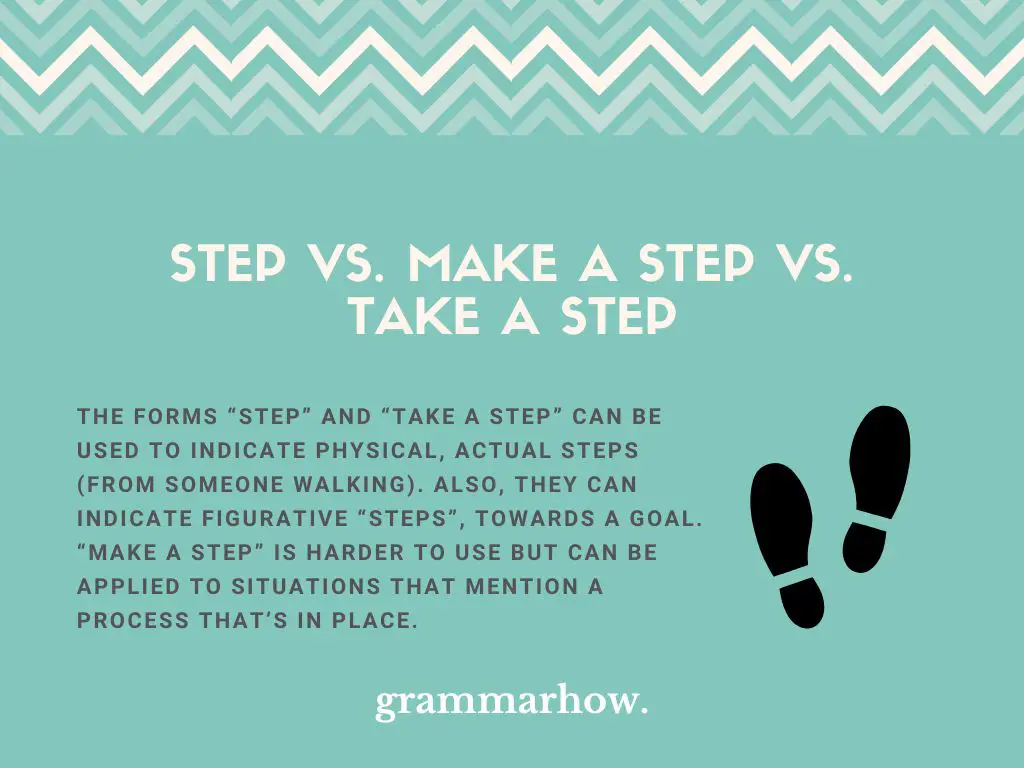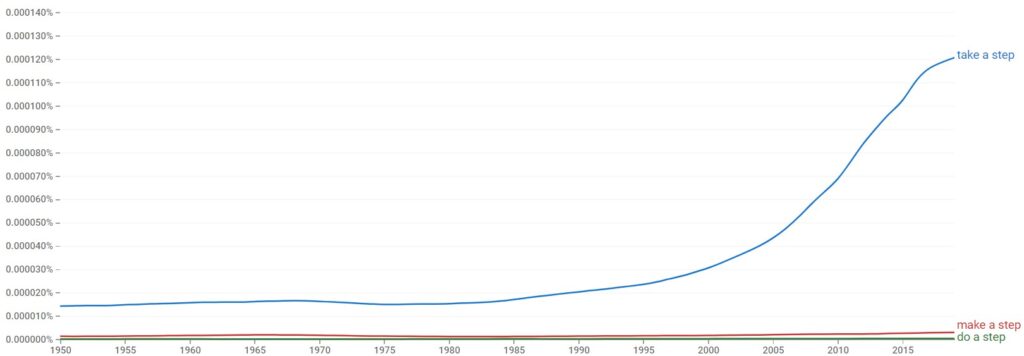Imagine you’re talking about the act of moving forward (literally or figuratively). Do you express it using “Step” only, “Make as Step”, or “Take a Step”?
We’ll take the time to look into each form, find out its meaning and correct usage, as well as look at helpful examples.
Step vs. Make a Step vs. Take a Step
The forms “Step” and “Take a Step” can be used to indicate physical, actual steps (from someone walking). Also, they can indicate figurative “Steps”, towards a goal. “Make a Step” is harder to use but can be applied to situations that mention a process that’s in place.

Let’s take a look at some examples:
- Step forward if you are wearing a red shirt.
- Make a step forward if you are wearing a red shirt. (incorrect)
- If you are wearing a red shirt, please take a step forward.
The examples reflect a situation in which individuals wearing red t-short are supposed to “Take a Step” forward.
The first sentence uses only the word “Step” and is grammatically correct. It’s also the most assertive form, that delivers the message in a very direct manner. If you like to be straight to the point, that’s certainly a form you can use.
The second sentence uses “Make a Step”. Although it’s grammatically correct, it doesn’t sound idiomatic. People don’t usually speak that way, and we recommend that you avoid this form for actual, physical steps forward.
The third sentence is a bit more polished. The order of the word in the sentence is changed, and it uses “Take a Step” to convey the message. It’s also grammatically correct and is the form you should use if you are addressing a formal or polished audience.
Step
“Step” in the context we’re looking here refers to a stage in a process, that may or not involve taking a physical “Step” forward or towards a goal. It can be used in any verb tense, depending on when the action took (or will take) place.
Take a look at the examples below:
- Please step to the back of the stage, right now.
- Do you mind stepping backward?
- Paul wasn’t careful when he stepped off the attraction.
- The chair is five steps ahead of you.
- I’m sending a list of the steps included in the project to the team.
“Step” by itself, usually brings a very direct, assertive tone to the sentence. If that’s how you’d like to express yourself, feel free to use “Step”.
Make a Step
“Make a Step” is a phrase with a very specific use. It only works when we’re referring to steps taken in a project we’re involved in. In other words, if you mean “incremental steps toward a goal”, “Make a Step” can be used. Otherwise, choose a different form.
- There’s still a long way to go, but we’re making steps toward our goal.
- Julia is making a step at a time, as she starts her enterprise.
- We need to decide what steps we’ll make in the next stage of the project.
- Please, make a few steps forward, Sir. (incorrect)
- Please, take a few steps forward, Sir.
Sentences 1 to 3 show examples in which “Make a Step” is acceptable and can be used. Keep in mind that all of them refer to professional (or technical) endeavors and not physical steps. “Make a Step” only works in that context.
Sentences 4 and 5 show an incorrect use of “Make a Step” followed by a correct version of the same sentence, using “Take a Step” instead.
Take a Step
“Take a Step” is a set phrase that indicates both a physical step a person can take to move around and a figurative step, concerning a project or toward a goal.
Take a look at some examples below:
- Take a step to your right, take the elevator and go up to the second floor.
- Be careful when taking a step over the puddle, Chris.
- Everyone who is in Group 3, please take a step forward.
- We must take a few steps to avoid shutting down.
- Take a step away from me immediately.
Do a Step
“Do a Step”, doesn’t work in the context of taking a step forward. It can work as a synonym for “Follow the Steps”, if we make a minor change and use it as “Do the Steps” – in other words, indicating we’re following the steps on a set of instructions.
Take a look at some examples that show “Do a Step” being incorrectly used, followed by a corrected version of the same sentence:
- Please do a step away. (incorrect)
- Please take a step away.
- Attention all, please do a few steps to your right. (incorrect)
- Attention all, please take a few steps to your right.
- The installation won’t be done correctly unless you do the steps on the instructions.
- Isaiah needs to do all the steps on the recipe if he wants to cook the stew.
Sentences 5 and 6 show “Do the Step” being correctly used – but notice that it isn’t “Do a Step”, exactly. It’s an adjusted variation that includes “the” as opposed to “a”.
Which Is Used the Most?
We’re curious to find out which one of the forms is used more often, “Take a Step”, “Make a Step” or “Do a Step”? Take a look at the graph from Google Ngram Viewer below.

“Take a Step” is by far the most used one. We weren’t surprised by that, because “Take a Step” is the correct expression that can be easily applied to most sentences. It’s also the one most of us are familiar with and, consequently, use more.
“Make a Step” is closer to the bottom of the graph – which, considering it has a very strict use also makes sense. While “Do a Step” is barely used.
Keep in mind that “Do a Step” is incorrect, and all incorrect forms should be avoided.
Final Thoughts
When talking about moving forward, literally or figuratively, you can use the forms “Step” and “Take a Step”. They’re grammatically correct and fit in most of the sentences. “Make a Step” is appropriate only when talking about the steps of a project or enterprise.
